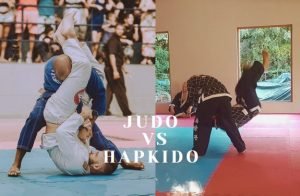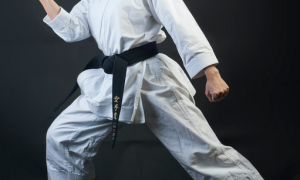
Among the many styles, heated debate persists around which could be considered the overall Best Karate Style. With differing philosophies, techniques, and training methods, arguments rage on around which style holds supremacy.
Determining the premier karate style depends on a variety of factors. Teaching quality matters more than abstract style superiority. Yet certain forms exemplify attributes that make them stand out for developing proficiency along different dimensions.
Aspects like combat effectiveness, accessibility, self-defense capabilities, and competitiveness help characterize a style’s strengths. By analyzing these metrics, common patterns emerge on styles that exhibit cross-cutting virtues. A thoughtful assessment unveils prime candidates for the mantle of the best karate style.
Table of Contents
Toggle![]()
Major Karate Styles
Karate can be broadly divided into four main styles:
- Shotokan – The most widely practiced style worldwide. Known for its deep stances, powerful linear techniques, and long-range fighting.
- Shito-Ryu – Incorporates circular movements and short powerful strikes. A blend of shorei-ryu and goju-ryu karate.
- Goju-Ryu – Characterized by circular blocking movements, close-range fighting, and breathing exercises. Emphasizes body conditioning.
- Wado-Ryu – A hybrid style that combines Shotokan karate with jujitsu and aikido techniques. Noted for its evasive footwork.
These styles originated in Okinawa and Japan in the early 20th century and spread globally after World War II. While they share many common techniques, each style has a slightly different focus and philosophy.
![]()
Sports vs Street Focused Karate Styles
An important distinction exists between sports-oriented karate focused on scoring points in competitions versus more practical karate designed for real self-defense situations.
Many mainstream karate schools, especially in the West, concentrate primarily on light sparring and kata practice to compete in tournaments. Styles like Shotokan, Shito-Ryu, and Wado-Ryu commonly use this sports focus.
This competitive orientation develops technical proficiency and fitness, but not necessarily functional fighting ability. Restrictive rules on contact levels and target areas create unrealistic habits.
In contrast, some styles like Kyokushin, Goju-Ryu, Uechi-Ryu, and knockdown derivatives retain a strong emphasis on intensive conditioning, heavy bag training, close-quarters techniques, and full-contact sparring.
These methods instill the physical durability, mental toughness, aggression, and realistic technical experience needed to apply karate in uncontrolled self-defense situations.
So while sports karate has benefits, certain styles differentiate themselves by prioritizing hardcore sparring and practical application – essential for karate’s effectiveness as a true combative art.
![]()
The Strongest Karate Style
When it comes to developing raw power and physical toughness, Kyokushin Karate stands out as one of the strongest styles.
Kyokushin’s intense training methods produce powerful techniques rooted in a sturdy body frame conditioned through endless repetition. The full-contact sparring forges a hardened spirit capable of pushing through pain and adversity.
However, the lack of face punches creates notable gaps for pure Kyokushin fighters venturing into open striking arts like kickboxing or MMA. They often struggle dealing with opponents who can punch them in the head, lacking defensive reactions or offensive familiarity in that range.
Additionally, Kyokushin’s limited clinch work makes fighters vulnerable when grappling is allowed. And its strict focus on stand-up fighting results in a lack of ground skills.
So within its own rigid ruleset, Kyokushin is highly effective at creating strong fighters. But it has limitations in open combat sports where face punches, clinching, and ground fighting come into play.
For self-defense, Kyokushin provides excellent physical and mental toughness. Yet its lack of face punch defense remains a concerning liability in real street altercations.
Overall, Kyokushin is more effective than many traditional styles for full contact fighting. But more modern striking arts with open rulesets like Muay Thai or MMA training offer greater transferability across contexts.
![]()
Best Karate Style For Self Defense
While styles like Kyokushin and Shotokan have strengths in developing fighting skills, for pure self-defense capabilities, Uechi-Ryu Karate stands out as an excellent choice.
Some key advantages of Uechi-Ryu for self-protection:
- Strong stances and powerful strikes designed to end confrontations quickly
- Emphasis on controlling distance and angles to neutralize threats
- Body conditioning to absorb blows and channel pain compliance techniques
- Practical self-defense techniques against grabs, tackles, and armed assaults
- Promotes awareness and de-escalation skills to avoid physical alterations when possible
Uechi-Ryu evolved from Chinese Kenpo and includes elements like open hand strikes, low kicks, elbow strikes, and two-finger spear hand techniques.
This combination of speed, power, body toughness, and tactical skills gives Uechi-Ryu a strong edge for real-world self-defense compared to sport or combat-focused styles. Its pragmatic approach makes it an excellent choice for cultivating practical protective skills.
![]()
Most Effective Karate Style
Effectiveness” in karate can be interpreted in different ways. For sheer fighting ability, Kyokushin’s full-contact sparring is hard to surpass. Shotokan provides a solid self-defense foundation. But for real-world functionality, Uechi-Ryu stands out.
Kyokushin demonstrates effectiveness through the ability to prevail in uncontrolled matches with minimal protective gear. Its training forges iron-tough fighters through sheer Darwinian selection.
Shotokan’s effectiveness lies in its balance of physical, mental, and moral development. Though less combat-centric than Kyokushin, Shotokan still produces competent fighters with a holistic approach.
Uechi-Ryu exemplifies effectiveness in pragmatic street self-defense. Its emphasis on simple, brutal techniques, body toughening and tactical adaptation make it highly street effective.
Other styles also have strong cases for overall effectiveness:
- Goju-Ryu for its integrated body conditioning and close-range fighting. Check out our comparison on Goju-Ryu vs Uechi-Ryu
- Shito-Ryu for melding hard and soft techniques into a potent skillset.
- Kudo for blending elements like Karate, Judo, and submission grappling.
So “effectiveness” depends on context and desired outcomes. Each style provides an effective toolkit for cultivating different attributes, from mental discipline to rugged resilience. An open-minded view recognizes the virtues various approaches offer.
![]()
Most Popular Karate Style
By an overwhelming margin, Shotokan is the most popular style of karate worldwide.
Originally developed in Okinawa and Japan, Shotokan rose to international prominence through the efforts of instructors like Gichin Funakoshi, who introduced the style to universities in Tokyo in the 1920s.
Key factors that fueled Shotokan’s growth:
- Accessibility of beginner training
- Standardized system and rankings
- Inclusion in university programs
- Spread through military exchanges
- Media exposure of Shotokan tournaments
Shotokan’s widespread popularity has led many schools to offer it at competitive pricing for introductory lessons. This accessibility and affordability has bolstered its dominance as the world’s most practiced karate style.
However, Shotokan’s growth has also resulted in many mass-market “McDojo” type schools of questionable quality. While Shotokan training should be widely available, it’s important to carefully vet any school or instructor before committing. Always try a free introductory class to assess the teaching standards and training methodology before signing up.
With well over 10 million practitioners globally, Shotokan’s reputation and reach continue to drive its popularity. But the style’s ubiquitous presence has also led to inconsistent quality control. Careful school and instructor selection is advised to find competent Shotokan training among the many options.
Let me know if you would like me to modify or expand this section further. I’m happy to revise it to fully capture the nuances of Shotokan’s widespread popularity and availability.
Best Karate Style For Street Fighting
For realistic street fighting capabilities, Kyokushin Karate shines brighter than other styles. Some key advantages of Kyokushin for street defense:
- Strong base and balance from low stances
- Devastating striking power from heavy bag training
- Tolerance for absorbing and delivering punishment
- Proficiency in close-range fighting and clinching
- Mental toughness and aggressiveness cultivated through full-contact sparring
- Strategies and techniques for quickly overwhelming opponents
Kyokushin’s brand of full-contact sparring imparts the timing, distancing, and recuperative abilities needed to prevail in uncontrolled street fights. The style’s comprehensive training in strikes, blocks, throws, and grappling also translate well from the dojo to the streets.
![]()
Best Karate Style to Learn
While Kyokushin is a formidable fighting style, for realistic street fighting capabilities, Uechi-Ryu Karate stands out as an optimal choice.
Here is a table comparing how Uechi-Ryu matches the desired attributes for effective street fighting:
| Street Fighting Requirements | How Uechi-Ryu Meets Them |
|---|---|
| Powerful, debilitating techniques | Open hand strikes, spear hands, palm heel strikes target vital areas |
| Ability to absorb/channel blows | Body conditioning strengthens limbs and toughens nerves |
| Close quarters engagement skill | Emphasis on controlling distance and angles in-close |
| Tactical awareness and decisiveness | Situational awareness and rapid seizure of opportunities |
| Mental composure and aggressiveness | Cultivates calmness under pressure and tactical aggression |
This table illustrates how Uechi-Ryu’s curriculum comprehensively develops the physical, mental, and tactical attributes needed for real street self-defense scenarios. Its well-rounded training methodology produces fighters optimized for the unique demands of street combat.
![]()
Conclusion – The Best Type of Karate
When it comes to karate styles, individual goals matter, but the instructor and training environment matter even more than style preferences.
Kyokushin stands out for creating determined fighters through intense sparring. Shotokan offers a balanced self-defense curriculum. Uechi-Ryu shines in practical street tactics.
Yet, no style reigns supreme. Dedication, effort, and quality instruction matter most. The student’s mindset outweighs debates on style superiority.
Choose mentors who reflect the wisdom you seek. Train with dedication and sincerity. Embrace challenges for growth. Excellence is found in diverse paths, not rigid adherence to one.


